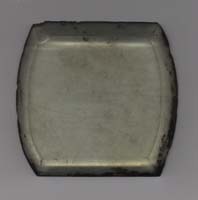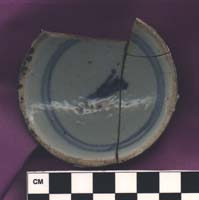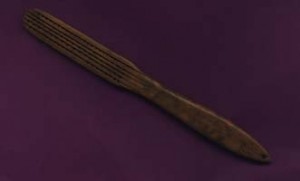It’s not uncommon for archaeologists to find objects that baffle them. This week our project update provides images of two such artifacts that we have come across during our cataloging of the Market Street collection, which we either haven’t been able to fully identify or that were tricky at first. We are hoping that you might be able to help us by sharing your knowledge with us about these pieces! This first artifact is a flat, beveled piece of leaded glass. It is roughly square in shape, with two parallel sides, and two sides that bow outwards. There is a residue adhering to the outer edges of the object both on the beveled surface and on the underside. The residue is greenish-brown and compares favorably in color to a copper alloy, perhaps suggesting that this piece of glass was originally mounted in a metal casing. The artifact measures 85mm x 80mm x 9mm.
An artifact that took some time to identify is this porcelain dish. Decorations on the dish were hand-painted in blue underneath the glaze. The pattern consists of two concentric circles around the rim and an unidentified image in the central medallion. The underside is unglazed. A similar artifact found at the Riverside Chinatown was classified as “Southeast Asian Porcelain,” a term which refers to Chinese-produced ceramics found commonly at archaeological sites in Southeast Asia. Looking at the size, shape, and fabric of this vessel, it resembles a small condiment dish. The vessel also has a black residue on part of its rim. But what is it? This is where comparative collections, reference books, and the work of other archaeologists and historians really help! By consulting the report of excavations of a Los Angeles Chinatown occupied in an overlapping time period, we found that dishes like this one were often used as small lamps. Peanut oil or animal fat was poured into the dish, and then a wick was put in and ignited. Roberta Greenwood, the author of this book, also found blackened, burnt residue on similar artifacts from her work in Los Angeles.
Artifact of the Week
Since we presented two artifacts that were (and are!) difficult to identify, our artifact of the week is one that is fairly easy to recognize. This is a toothbrush, made out of bone. The “head” of the toothbrush contained several long rows of bristles. Although these toothbrushes are not very different in overall design from other toothbrushes of the nineteenth century, or from modern toothbrushes for that matter, they are recognizable as Asian toothbrushes due to a very distinctive trait. The holes for the bristle go all the way through the toothbrush, while European and Euroamerican toothbrushes of the time did not have holes for bristles that penetrated all the way through the handle. The design of the Asian toothbrush allowed the bristles to be replaced. Bristles would be inserted from the front of the toothbrush, then bent and inserted through the back. The bristles would then be cut to create a “brushing” surface. That these brushes were used for quite some time is attested by the degree to which their handles have been worn over time.



Last week while working on a special finds box I had the task of sorting a bag that contained severals pieces of jade and glass bracelets. At first glance I assumed that all of the bracelets were jade because the pieces were just about the same shade of green and had the heft of stone. I later learned that the corrosian found on several of the pieces was a sign that they were in fact glass, and on closer examination the broken edges had the same sparkly look as the edge of a broken bottle. What is really interesting to me is that both jade and glass bracelets were found on the same site. I wonder what that might say about differences in class, or maybe everyday vs. special occasion jewlery. If anybody has any ideas I’d love to hear them.
Gina